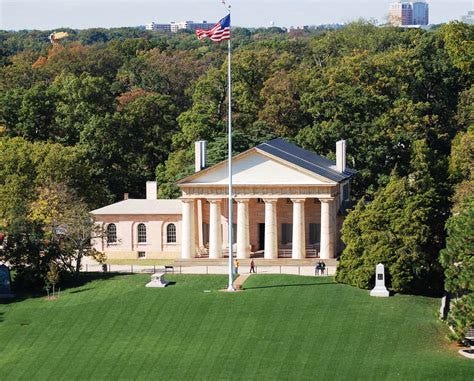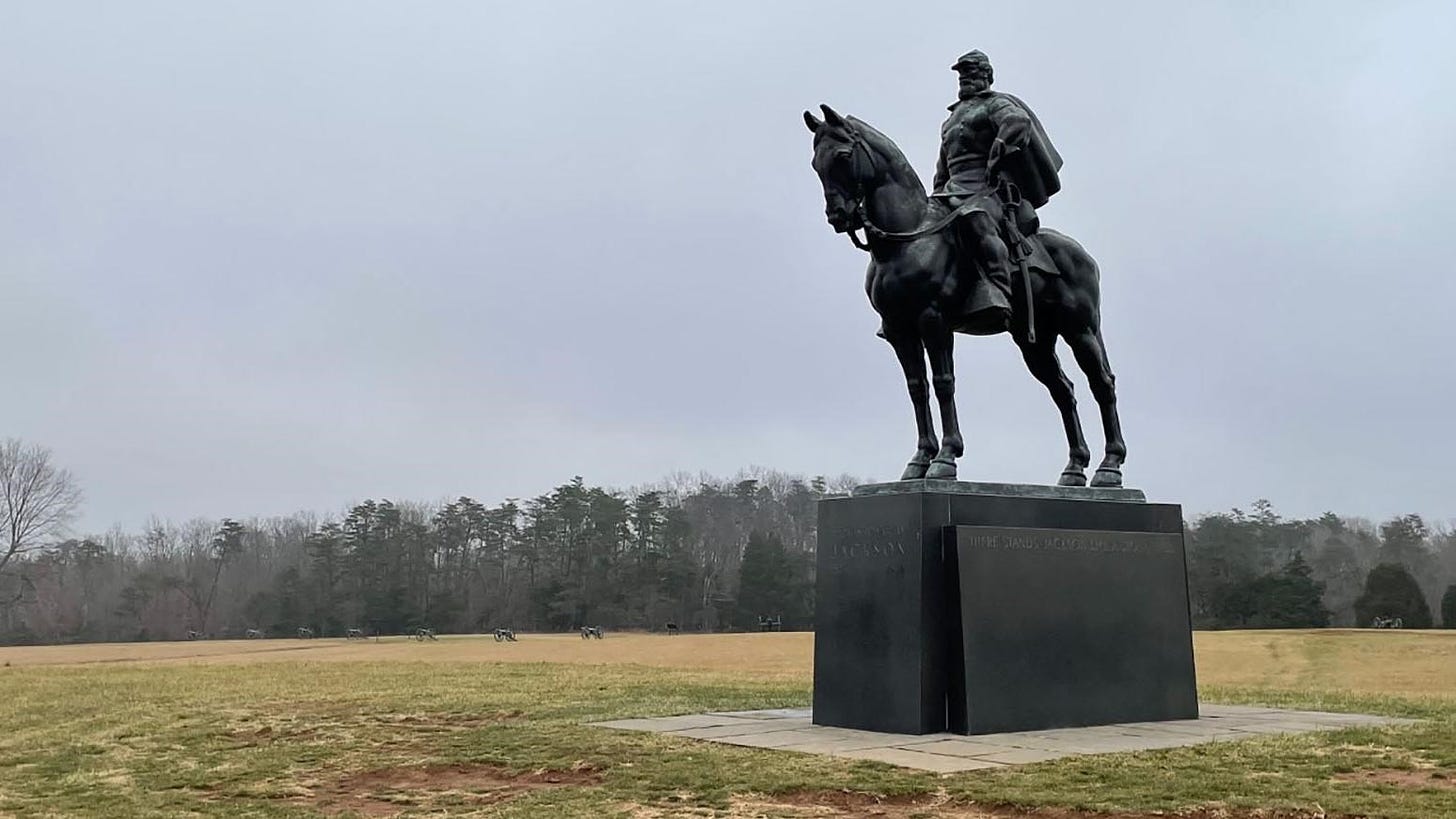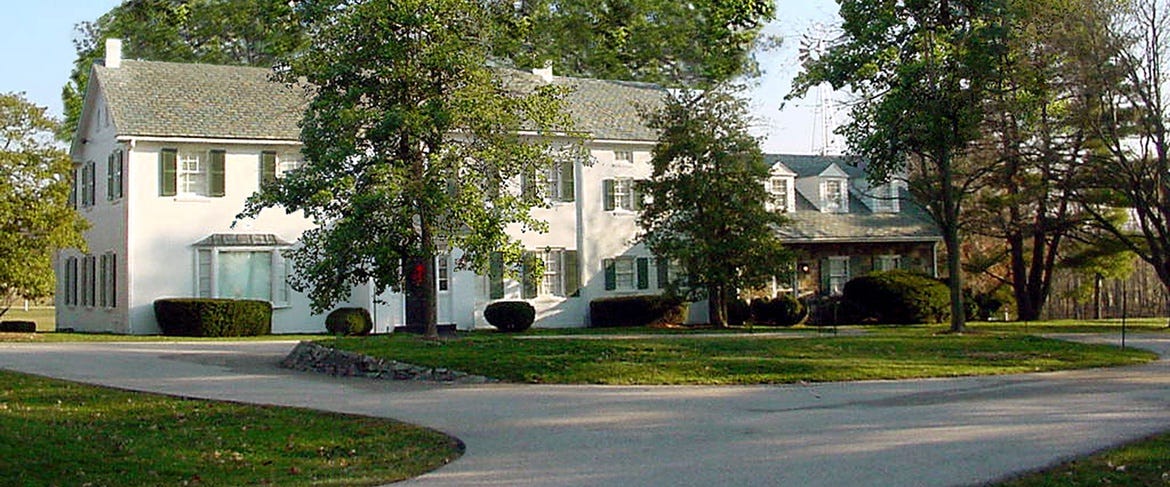Ricochet is the best place on the internet to discuss the issues of the day, either through commenting on posts or writing your own for our active and dynamic community in a fully moderated environment. In addition, the Ricochet Audio Network offers over 50 original podcasts with new episodes released every day.
 Here We Go Again: More Presentism
Here We Go Again: More Presentism
You do not teach history by rewriting or removing it. But you might just revisit it.
That obvious truism has escaped the conscientiousness of Virginia’s 8th District US Representative, wealthy foreign auto dealer Don Beyer and the Commonwealth’s equally woke junior US Senator, Tim Kaine, both Democrats who are pursuing legislation to remove Robert E. Lee’s name from the Robert E. Lee Memorial (Arlington House), a home his wife inherited from his father-in-law and stepson of George Washington, and lived in briefly.

The Confederate Memorial, Arlington National Cemetery, encircled by graves of confederate dead.
Now, an “independent panel” empowered by Congress to review military bases and other installations is looking to erase history at Arlington National Cemetery by removing a memorial credited to the Daughters of the Confederacy, but largely placed by none other than former Union soldier and President William McKinley.
From Northern Virginia Magazine:
An independent commission tasked with implementing sweeping name changes to nine Army bases, two Navy ships, numerous base roads, buildings, athletic fields, and more that honor the Confederacy is saying the total endeavor will cost over $62 million. (Emphasis added)
The Naming Commission, which was assembled in 2020 as part of the U.S. military’s effort to combat racial injustice, has identified approximately 1,100 examples of military-affiliated properties and resources that require renaming, according to the Associated Press.
Among the list of recommendations is the removal of a Confederate Memorial at Arlington National Cemetery, which retired Army Brig. Gen. Ty Seidule, the commission’s vice chair, called “problematic from top to bottom.”
Unveiled in 1914 in Section 16 of the cemetery, the memorial, which was designed by Confederate veteran Moses Jacob Ezekiel, depicts a bronze woman crowned with olive leaves standing on a 32-foot-tall pedestal. On the pedestal are 14 shields engraved with the coats of arms of the 13 Confederate states and Maryland, which neither seceded nor joined the Confederacy.
At the feet of the woman, who represents the South, is the Biblical inscription, “They have beat their swords into plough-shares and their spears into pruning hooks.”
Your tax dollars at work.
Here’s what that “independent commission” probably didn’t take the time to learn, but The Federalist’s John Davidson did:
At the turn of the last century, our political leaders seemed to understand that the survival of a vast republic like ours depended on civic virtues like reconciliation, forgiveness, and actual tolerance. They knew this because many of them had lived through and participated in the Civil War. They had seen and felt for themselves what happens when a nation turns on itself, and they were determined not to let it happen again.
Ironically, the history of the Confederate memorial at Arlington is a perfect case in point. It was first conceived of by President William McKinley, a decorated Union veteran who saw combat at Antietam and in the Shenandoah Valley. During his presidential campaign in 1896, he witnessed untended Confederate graves in the South, and it disturbed him. At the time, the federal government prohibited the decoration of Confederate graves at Arlington, as it had since the end of the Civil War.
McKinley thought it was time for that to change. At a peace jubilee in December 1898 celebrating the end of the Spanish-American War (the first time since before the Civil War that Americans from both North and South were engaged in a military conflict with a foreign power), McKinley announced that the government would henceforth tend to the graves of Confederate dead buried in federal cemeteries, saying they represented a “tribute to American valor.”
The speech prompted calls to disinter Confederate remains at Arlington, which were dispersed throughout the cemetery and mingled with Union graves, and rebury them in a specially designated Confederate section. Congress drafted legislation and provided funding, and McKinley signed the bill in June 1900.
The legislation didn’t mention a memorial, but the plans for the Confederate section laid out graves in a circular pattern around a cruciform set of walkways with a central grassy area that the Army Corps of Engineers marked on the plans with an “M,” for memorial.
It would take another 14 years for private groups (including Union veteran organizations) to raise the money and erect the Confederate memorial that stands in Arlington today. Anyone who has seen it knows that it reflects the sentiments of reconciliation and national unity that McKinley originally had in mind.
By recommending the removal of the memorial – built and placed there not with tax dollars, but private donations – the commission is effectively striking a blow against reconciliation and national unity under the evil guise of presentism – the horrible and prevalent practice of applying today’s “standards,” such as they are, to events and people of yesteryear.
There are few more damaging nonviolent trends in America today than the historical fallacy of presentism. The ultimate goal of its practitioners is no different than those of Joseph Stalin or Mao Tse Tung during their rise into arguably the most murderous dictators of the mid-20th century – the acquisition and maintenance of power, and rewriting or erasing history to help achieve it. You can add another tyrant from Germany’s Third Reich if you’d like. A certain murderous communist dictator from Cambodia also comes to mind.
That may seem inflammatory and excessive, even uncivil and offensive. Yet our modern-day revisionists employ their presentism in much the same way. Consider Mao’s “Cultural Revolution.” If it walks and talks like a duck, it’s probably a duck.

The Robert E. Lee Memorial, Arlington House, Arlington National Cemetery
For many of us, it’s hard to get upset over things like changing the names of military bases and monuments. Robert E. Lee, in particular, did not want confederate monuments or to be memorialized himself after the Civil War, as he helped facilitate the nation’s reunification after “the late unpleasantness.” I’ve never complained about removing statues honoring him in places like Richmond and Charlottesville, Virginia. But people should learn why there was such an effort to celebrate and honor reconciliation and reunification of the nation. The Thomas J. “Stonewall” Jackson statue at Manassas National Battlefield serves a particular historical purpose used by National Park Service rangers to teach what happened on that battlefield in 1861.

Congress adopted legislation in 1958 that symbolically granted pensions to confederate veterans on par with those of Union soldiers. Prior legislation passed in 1906 and again in 1929 authorized headstones and gravesites in federal cemeteries for confederate veterans.
Just before he left office in December 1960, President Dwight Eisenhower issued a proclamation calling on Americans to participate in the Centennial of the Civil War. Imagine our President today saying these words:
The years 1961 to 1965 will mark the one-hundredth anniversary of the American Civil War.
That war was America’s most tragic experience. But like most truly great tragedies, it carries with it an enduring lesson and a profound inspiration. It was a demonstration of heroism and sacrifice by men and women of both sides who valued principle above life itself and whose devotion to duty is a part of our Nation’s noblest tradition.
Both sections of our now magnificently reunited country sent into their armies men who became soldiers as good as any who ever fought under any flag. Military history records nothing finer than the courage and spirit displayed at such battles as Chickamauga, Antietam, Kennesaw Mountain, and Gettysburg. That America could produce men so valiant and so enduring is a matter for deep and abiding pride.
The same spirit on the part of the people at home supported and strengthened those soldiers through four years of great trial. That a Nation which contained hardly more than thirty million people, North and South together, could sustain six hundred thousand deaths without faltering is a lasting testimonial to something unconquerable in the American spirit. And that a transcending sense of unity and larger common purpose could, in the end, cause the men and women who had suffered so greatly to close ranks once the contest ended and to go on together to build a greater, freer, and happier America must be a source of inspiration as long as our country may last.
Now, there was a President – also a national war hero and Gettysburg resident – who understood the American story, warts and all, and especially our reconciliation and reunification journey after that horrific rebellion. We could use a President (and Members of Congress) like that today, instead of one who divides and targets Americans under the false pretenses of a sinister “Soul of the Nation” speech.
We deserve better, both from that independent commission and from the occupant of the White House. Much better. I can also think of better uses for $62 million to rename military installations.
As for history, I mostly agree with Virginia Governor Glenn Youngkin: “I do feel very strongly that those statues should be placed in museums or on a battlefield so that we can preserve our history and know it. I have a very strong belief that we can’t know where we’re going unless we know where we’re from.”
Cemeteries, too.

Gettysburg home of President Dwight D. Eisenhower.




This is a key point. There are some who find comfort in removing these memorials. They feel that will promote some kind of reconciliation.
They decline to understand the memorials were erected to provide comfort and reconciliation to those who remembered the war.
As I said in my post, so far, the Commission has run up a tab of 21 million dollars.
However, the cost of making all these changes has come to 68 million dollars so far.
That’s a lot of money to be “correct”.
History – good, bad and in-between should be preserved for what it is and not removed. If something needs to be removed, it should be voted on by the community and state in which it resides.
Language warning, of course:
Arlington should be voted on by everyone. It is national. I am sick and tired of these changes being made by commissions on my behalf without me having a say in it. My Congressman and both Senators are Democrats, so I have no representation at the moment as they are reliable leftists. So what can be done here? If we want to say something, to whom do we say it?
How are we ever going to learn not to repeat the mistakes of the past if we don’t know what those mistakes are? And by knowing about those mistakes, I don’t mean learning some cartoon version of a Manichean conflict, but how ordinary people, in the process of doing admirable things, can abuse power and do so much wrong to people, and how they saw and remembered themselves.